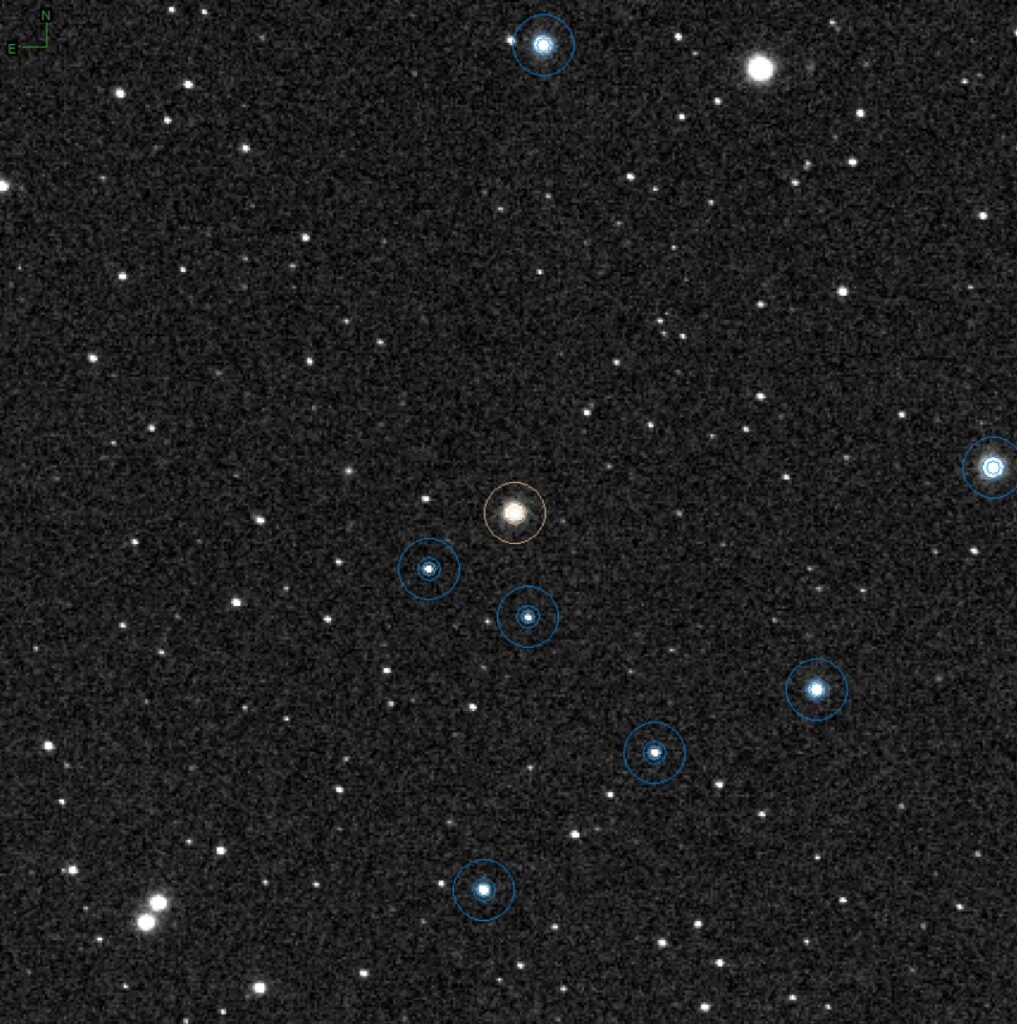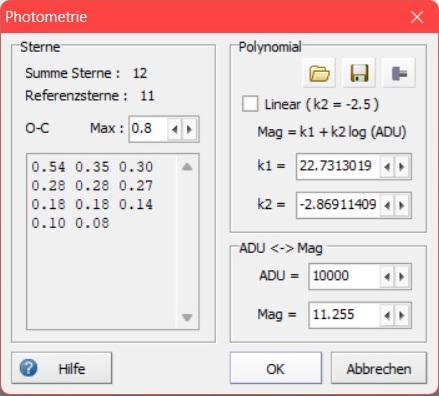An article by Thomas Grunge, June 2025.
Starry nights could be counted on a few fingers at the ITV 2025 in Gedern. But on 30.05.2025 the time had come. 20 images of T CrB in the constellation Northern Crown were taken. I planned to measure the star photometrically. Biases, darks, flats and lights were therefore also made.

Specifications
20x25s Frames with Canon EOS 750Da, Gain 1600, UV-IR-Cut (Baader), TS-Photoline 60/360, ZWO AM3, William UniGuide 32mm whith ZWO-ASI 174MC. Flatfieldfolie Aurora by Gerd Neumann. Imageing Software N.I.N.A.
At the moment, this star is of interest because it not only fluctuates regularly in brightness, but also because a nova event is imminent in the near future look here [1] and look here [2] Strictly speaking, it is a double star consisting of a "red giant" and a "white dwarf". What sounds like something out of Grimm's fairy tale is a cataclysmic star system that orbits each other in about 228 days and in which hydrogen gas is transferred. The hydrogen gas continues to accumulate on the surface of the white dwarf until a thermonuclear chain reaction occurs. This creates an explosive burst of brightness. The star increases its brightness by about 10,000 times and is then visible to the naked eye for a short time. This process is repeated regularly about every 80 years.
AstroArt

The AstroArt software has been around since 1998 and has been continuously developed since then. AstroArt has a scientific approach and was originally designed as an astrometry and photometry program. Step by step, control of telescope hardware and advanced image editing tools were added. The current, paid version can be found look here [3].
From my decades of experience with the program, I can recommend AstroArt when it comes to evaluating your own astro images astrometrically and photometrically.
Photometric evaluation
At the beginning, all recordings must be converted to the Fits format, calibrated with darks, flats and biases, aligned and added. It should be noted that these are color images and we only want to evaluate the green pixels of the Bayer matrix [4]. This entire image processing can be carried out in AstroArt in one operation (see settings in the figures). The result is a low-noise sum image of the green channel, which serves as the basis for photometry.

Then the sum image is solved astrometrically with AstroArt (platesolving). Now you can select T CrB with the mouse. The coordinates are automatically entered into a table with the position in RA and DEC. Here you can check again whether these are the correct coordinates of T CrB.

Photometry requires a series of stars with known V-brightnesses. This allows AstroArt to calculate a polynomial, which represents the transfer function between pixel values and magnitudes for the sum image. For this purpose, a findercart mit der zugehören photometric table by AAVSO [5]. The marked stars are clicked on the sum image and the corresponding V-brightness is entered in the AstroArt table. Then the transfer polynomial is calculated with the photometry tool in AstroArt

Now you can select any stars in the sum image and read the V brightnesses.
The V-brightness of T CrB results in a value of 9,971 magnitudes.
Comparing this result with average values from the AAVSO light curve for V-brightness at 30.05.2025, the result is a very good agreement. The deviation is only 0.003 magnitudes!

Of course, this method is also suitable for the red and blue channels of the recording. This requires R and B brightnesses of the comparison stars, which can be obtained from star catalogues, for example. However, the red and blue pixels of the Bayer matrix do not match the Johnson filters as well as the green pixels. Therefore, the deviations will become greater.
Photometry of stars can be exciting. Let's wait until we start with the Nova from T CrB. According to Adam Riese, it will be in 2026, but you can never know – possibly not until 2027. 😉
Sources
[1] Das Sternbild Corona Borealis https://kosmos-os.de/die-noerdliche-krone/
[2] TCrB – Die Nova in Spe https://kosmos-os.de/t-coronae-borealis-die-nova-in-spe/
[3] AstroArt: https://www.msb-astroart.com/
[4] Bayer Matrix: https://de.wikipedia.org/wiki/Bayer-Sensor
[5] AAVSO: https://www.aavso.org/